The SIP Proxy is a proxy/masquerading daemon for the SIP and RTP protocol. The SIP (Session Initiation Protocol, RFC3261) and RTP (Real-time Transport Protocol) are used by Voice over IP (VoIP) devices to establish telephone calls and carry voice streams. The proxy handles registrations of SIP clients on a private IP network and performs rewriting of the SIP message bodies to make SIP connections possible through the firewall and therefore make SIP clients (like x-lite, kphone, linphone or VoIP hardware) able to work behind NAT. Without this proxy, connections between clients are not possible at all if both are behind NAT, since one client can't reach the other directly and therefore no RTP connection can be established between them.
- Enabled on zone
This enables the SIP Proxy to listen for requests on the selected port (default: 5060)
- Transparent on zone
If transparent mode is enabled, all requests for the destination port 5060 will be forwarded to the SIP Proxy without the need of any special configuration changes on your clients.
- SIP Port
Port to listen on for incoming SIP messages.(default:5060)
- RTP Port low / RTP Port high
UDP Port range which the SIP proxy will use for incoming and outgoing RTP traffic. By default the range 7070 up to (and including) 7090 is used. This allows up to 10 simultaneous calls (2 ports per call). If you need more simultaneous calls, increase the range.
- Autosave Registration
This allows the SIP proxy to remember registration across a restart.
- Time
Save the registration file after every amount of seconds specified by this field.
- Outbound Proxy Host/Port
The SIP Proxy itself can be told to send all traffic to another outbound proxy.
- Log Calls
This enables logging of established calls. You will see the logging entries within siproxy logviewer. (See the section called “SIProxy log page”)
- Firewall logs outgoing connections
Tick this on if you want the firewall to log all outgoing connection. Note that in some countries this may be illegal.
- Save and Restart
Save the settings and restart the SIP proxy by clicking the Save and restart button.
Note
Some VoIP devices need special configuration in order to be able to cooperate with the SIP proxy. We noticed especially on snom phones the necessity to enable Support for broken registrars in order to have it fully functional.
